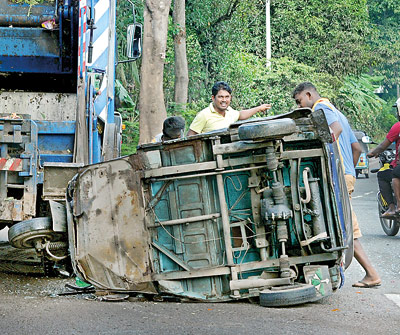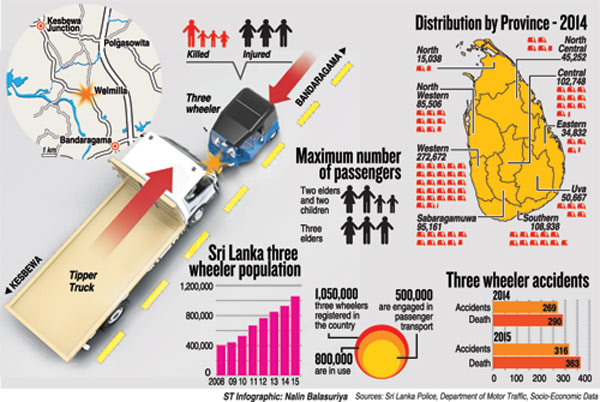News
Children’s deaths show three-wheeler laws must be tightened

Terror on the road: An accident last month in Kolonnawa. Pic by Amila Gamage
The death of three children riding a three-wheeler crammed with seven people has again raised concerns about overcrowding in these vehicles.
The teenaged driver of the three-wheeler was a fourth fatality of the accident resulting from a collision with a truck on the Bandaragama-Kesbewa main road.
Last year alone, 41 children under the age of 15 were killed in road accidents while 23 under the age of five years also perished.
In the most recent accident, three children, aged between four and 13 years, died on the spot while the 19-year-old driver succumbed to his injuries in hospital.
Police said three-wheeler drivers often ignore the rule prohibiting more than three adults or two adults and two children riding in the passenger seat.
With accidents and traffic deaths increasing from three-wheelers the authorities are also contemplating many new regulations including wearing of seatbelts in the vehicles.
Registration of Motor Vehicles (RMV) Commissioner General Jagath Chandrasiri said safety rules relating to three-wheelers was only addressed in the vehicle registration guideline and construction regulations.
According to construction regulations, a passenger should be allocated 383mm (15 inches) in a vehicle. The width of a three-wheeler is 1,115mm.
In collaboration with the World Health Organisation the authorities also plan to train three-wheeler drivers in first aid and give them special training in the transportation of injured people to hospital, a senior official of National Council for Road Safety (NCRS) said.
“This programme awards a certificate to those who have completed the training course. A first aid box will be installed in their vehicles,”, NCRS Chairman Dr. Sisira Kodagoda said.
Safety zones are to be declared within Colombo city limits and other parts of the country especially in proximity to schools. A pilot project has been launched near D.S. Senananayake College in Colombo, Dr. Kodagoda said.
There are 1,050,000 registered three-wheelers, of which an estimated 800,000 are in use, 500,000 of those engaged in passenger transport.
Police have issued a new circular enforcing strict adherence to traffic rules by three-wheeler drivers.
| Passenger killed while sticking his head out of vehicle A 26 year-old man travelling in a three-wheeler was killed when he stuck his head out of the moving vehicle and hit a bus, at Mount Lavinia last Sunday, the Coroner’s Court was told. The victim was identified as W.D. P Chathurange from Boreslesgamuwa. The bus driver giving evidence said when he saw a three-wheeler heading in the opposite direction he steered the bus to a side, but the passenger in the three-wheeler had put his head out of the vehicle causing the accident. At the Postmortem, Judicial Medical Officer (JMO) Dr. Shashini Malaviarchchi said death was caused by excessive bleeding and sustained injuries. Deshani Samaraweera the inquirer into sudden deaths said the three wheeler driver should be produced in courts on March 10. |
Police Deputy Inspector General (Traffic), Amarasiri Senaratne said overcrowding, reckless driving and violation of rules would be targeted.
Traffic offences commonly committed by three-wheeler drivers include sudden turns without signalling. For this offence, the spot fine is Rs. 1,000, while court fines vary from Rs. 2,000 to Rs. 6,000.
The second highest offence is reckless and dangerous diving, for which there is no spot fine, while court fines vary from Rs. 3,500 to Rs. 5,000. There are no spot fines for speeding over the 40kph limit, only court penalties.
“A way to overcome most driving violations committed by drivers is to introduce tougher laws and road regulations with severe penalties combined with stringent law enforcement enforced in a uniform manner,” DIG Senaratne added.
Other safety measures, such as ensuring that the right side of the passenger seat is closed for passenger safety, should be observed by drivers, All-Island Three-Wheeler Drivers’ Union head Sudhil Jayaruk said.
“Laws should govern every aspect of a three-wheeler from its colour to driver’s ethics and training of drivers. We should have a certain dress and code of ethics for three-wheeler drivers,” retired DIG of Traffic Camillus Abeyegoonewardene said.
These vehicles should not be painted blue, green and black, which make them hard to spot at night, he said. Instead, beige, yellow or white should be enforced.
Sixty per cent of road accident victims travelled in three-wheelers, the former DIG said, adding, “I believe that a road safety audit should be conducted on every road to identify road accidents in terms of where, when and why.
Inadequate safety standards in vehicles are another major reason that has led to the increase of road accidents.”
There should be a state body to train and license three-wheeler drivers under a code of ethics, the Head of Moratuwa University’s Department of Transport and Logistics, Dr. T. Sivakumar said.
He said there was currently no training before a driving licence was issued, and no supervision afterwards, with nowhere for the public to lodge complaints.
Dr. Sivakumar said the matter needed urgent consideration because of the numbers of people usingthree-wheelers as affordable transport.
The Head Nurse of National Hospital, Colombo, Pushpa R. Zoysa, said most patients admitted to the hospital’s Intensive Care Unit were road accident victims. “The injuries are invariably long term and the severity is much higher than any other injury,” she said.
| Tuk-tuks multiply despite higher cost Three-wheelers cost Rs. 500,000 before the Budget and were bought for a Rs. 50,000 down payment, Registration of Motor Vehicles (RMV) Commissioner General Jagath Chandrasiri said. After the Budget, the cost rose to Rs. 600,000 and the deposit to Rs. 180,000 with the loan-to-value ratio coming down to 70 per cent from 90 per cent. Mr. Chandrasiri said last year alone approximately 105,286 three-wheelers had been registered, mainly in March (12,530) and June (12,338). |

